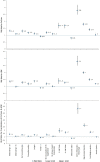Rates and risk factors for preterm birth and low birthweight in the global network sites in six low- and low middle-income countries
- PMID: 33334356
- PMCID: PMC7745351
- DOI: 10.1186/s12978-020-01029-z
Rates and risk factors for preterm birth and low birthweight in the global network sites in six low- and low middle-income countries
Abstract
Background: Preterm birth continues to be a major public health problem contributing to 75% of the neonatal mortality worldwide. Low birth weight (LBW) is an important but imperfect surrogate for prematurity when accurate assessment of gestational age is not possible. While there is overlap between preterm birth and LBW newborns, those that are both premature and LBW are at the highest risk of adverse neonatal outcomes. Understanding the epidemiology of preterm birth and LBW is important for prevention and improved care for at risk newborns, but in many countries, data are sparse and incomplete.
Methods: We conducted data analyses using the Global Network's (GN) population-based registry of pregnant women and their babies in rural communities in six low- and middle-income countries (Democratic Republic of Congo, Kenya, Zambia, Guatemala, India and Pakistan). We analyzed data from January 2014 to December 2018. Trained study staff enrolled all pregnant women in the study catchment area as early as possible during pregnancy and conducted follow-up visits shortly after delivery and at 42 days after delivery. We analyzed the rates of preterm birth, LBW and the combination of preterm birth and LBW and studied risk factors associated with these outcomes across the GN sites.
Results: A total of 272,192 live births were included in the analysis. The overall preterm birth rate was 12.6% (ranging from 8.6% in Belagavi, India to 21.8% in the Pakistani site). The overall LBW rate was 13.6% (ranging from 2.7% in the Kenyan site to 21.4% in the Pakistani site). The overall rate of both preterm birth and LBW was 5.5% (ranging from 1.2% in the Kenyan site to 11.0% in the Pakistani site). Risk factors associated with preterm birth, LBW and the combination were similar across sites and included nulliparity [RR - 1.27 (95% CI 1.21-1.33)], maternal age under 20 [RR 1.41 (95% CI 1.32-1.49)] years, severe antenatal hemorrhage [RR 5.18 95% CI 4.44-6.04)], hypertensive disorders [RR 2.74 (95% CI - 1.21-1.33], and 1-3 antenatal visits versus four or more [RR 1.68 (95% CI 1.55-1.83)].
Conclusions: Preterm birth, LBW and their combination continue to be common public health problems at some of the GN sites, particularly among young, nulliparous women who have received limited antenatal care services. Trial registration The identifier of the Maternal and Newborn Health Registry at ClinicalTrials.gov is NCT01073475.
Trial registration: The identifier of the Maternal and Newborn Health Registry at ClinicalTrials.gov is NCT01073475.
Keywords: Africa; Global network; Guatemala; India; Low and middle-income countries; Low birth weight; Preterm; Risk factors.
Conflict of interest statement
The authors have no relationships to disclose that may be deemed to influence the objectivity of this paper and its review. The authors report no commercial associations, either directly or through immediate family, in areas such as expert testimony, consulting, honoraria, stock holdings, equity interest, ownership, patent-licensing situations or employment that might pose a conflict of interest to this analysis. Additionally, the authors have no conflicts such as personal relationships or academic competition to disclose. The findings presented in this paper represent the views of the named authors only, and not the views of their institutions or organizations.
Figures



References
-
- Report of the Secretary-General. Sustainable Development Goals Report. United Nations Sustainable Development (Cited Sept 7 2019). https://www.un.org/sustainabledevelopment/progress-report/ Accessed 15 Ja 2020.
-
- WHO | Care of the preterm and low-birth-weight newborn. (Cited Aug 12 2019). https://www.who.int/maternal_child_adolescent/newborns/prematurity/en/ Accessed 15 Jan 2020.
-
- Lee AC, Katz J, Blencowe H, Cousens S, Kozuki N, Vogel JP, et al. National and regional estimates of term and preterm babies born small for gestational age in 138 low-income and middle-income countries in 2010. Lancet Glob Health. 2013;1(1):e26–36. doi: 10.1016/S2214-109X(13)70006-8. - DOI - PMC - PubMed
MeSH terms
Associated data
Grants and funding
LinkOut - more resources
Full Text Sources
Medical

